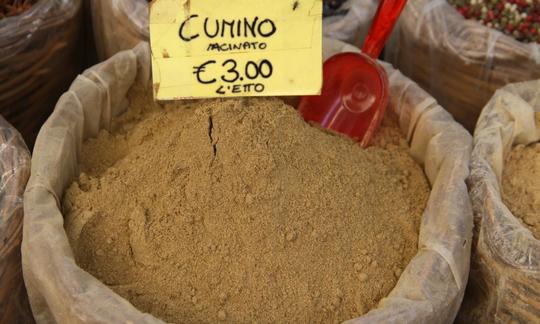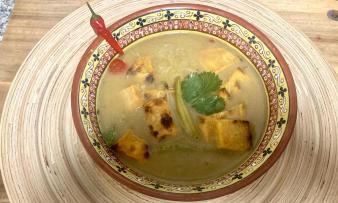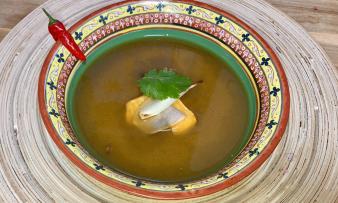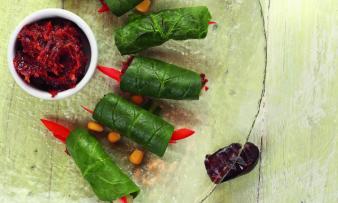Table of contents
Ground cumin ( Cuminum cyminum) is used fresh from the mill or mortar as a spice. It is an important ingredient in many curry spice mixtures.
Using cumin in the kitchen:
You can easily make ground cumin yourself from cumin seeds. This guarantees a more intense flavor than if you buy it ground (more on this below under "making your own"). Cumin is slightly hot, spicy and gives dishes a "full flavor". Cumin differs from caraway seeds ( Carum carvi), which taste milder.
Cumin plays an important role in North African, Turkish and Greek cuisine, as well as in the cuisines of the Middle East, Iran and India, as well as Mexico and Brazil. Ground cumin is found in many spice mixtures. Indian garam masala usually consists of cumin, cardamom,pepper, nutmeg, cinnamon, cloves, coriander, garlic and chili. Many curry mixtures contain cumin, fenugreek, ginger, cardamom and cinnamon in addition to turmeric and coriander.
A typical dish with ground cumin is falafel. These chickpea balls get their typical taste from cumin. Grind cooked chickpeas, cumin, salt,pepper, onion and garlic together in a blender, adding a little flour if the mixture is too sticky. Mix the parsley and coriander with the mixture and form the dough into small balls. Baking the balls in the oven is healthier than traditional deep-frying.
Vegan recipe for hummus:
Ingredients: 265 g chickpeas, 2 tbsp lemon juice, 3 tbsp tahini, 2-3 cloves of garlic, 1 tsp ground cumin, salt,pepper, 50 ml water.
Preparation: Cook the chickpeas and rinse well. Squeeze the lemon and peel the garlic. Put all the ingredients in a food processor or blender and mix everything for about 3-5 minutes until the hummus has a creamy consistency.
Vegan recipes with ground cumin can be found under the note: " Recipes that have the most of this ingredient ".
| Not only vegans or vegetarians should read this: Vegans often eat unhealthily. Avoidable nutritional mistakes. |
Shopping - where to buy?
Ground cumin can be found in major retailers such as Coop, Migros and sometimes in larger branches of Denner, Volg, Spar, Aldi, Lidl, Rewe, Edeka, Hofer all year round, sometimes also in organic quality (bio). You can also find ground cumin in organic shops, organic supermarkets (e.g. Alnatura or Denn's Biomarkt), health food stores and online.
You should prefer small quantities and use them quickly, as the aroma evaporates quickly. The harvest time for cumin varies depending on the growing area (see Cultivation - Harvest). 1 Ground cumin is available in stores all year round.
Making your own ground cumin:
Ground cumin is easy to make yourself. It is best to roast the cumin seeds briefly in a pan before crushing them in a mortar. This makes the flavor more intense. To make a fine powder, you can grind the seeds in a coffee grinder or an electric spice grinder.
Found in the wild:
Cumin can also be found growing wild in the growing areas (growing areas are listed under the origin and occurrence of cumin).
Storage:
The essential oils that give cumin its intense scent and great aroma evaporate quickly. This is especially the case with ground cumin. That's why it's worth buying small quantities. It's best to store ground cumin in a dry place in an airtight container. Alternatively, you can buy cumin seeds and grind them yourself when needed.
Ingredients - nutritional value - calories of cumin:
Here we show you the realistic ingredients of spices and herbs per 1 g (instead of per 100 g as usual - except for the amino acids).
The ingredients of ground cumin are taken from cumin seeds. If you grind them fresh, the values are comparable. The values may differ for ground cumin.
Ground cumin contains 3.75 kcal/1g. The fiber content is well measured at 0.1 g/1g. Proteins are also well represented at 0.18 g/1g. 2
The high iron content is striking. 1g of cumin contains 0.06g of iron, which corresponds to around 4.74% of the daily requirement. Marjoram (0.08g/1g) and basil (0.09g/1g) have similarly high values. Thyme covers around 8.8% of the daily iron requirement with 0.14g/1g. 2
The manganese, calcium and magnesium content is negligible in normal consumption quantities. Manganese is contained at 3.3 mg/100g. If consumed at 1g, this would cover 1.67% of the daily manganese requirement. 2 The calcium content at 931 mg/100g is similar to that of allspice (661 mg/100g), while poppy seeds contain 1438 mg/100g. 1g of cumin only covers 1.16% of the daily calcium requirement. Magnesium is contained at 366 mg/100g. 1g of cumin only covers 0.98% of the daily requirement. 2
The ratio of LA : ALA is 18:1 and is comparable to that of caraway seeds and pecans (21:1). 2 Since the Federal Nutrition Commission recommends a ratio of <5:1, caraway seeds do not have optimal values, but are not in the extremely deficient range either.
The complete ingredients of ground cumin, the coverage of the daily requirement and comparison values with other ingredients can be found in our nutrient tables. In the article Nutrients explained you will get a detailed insight into the topic.
Dangers - intolerances - side effects:
Cumin has fallen into disrepute because it contains high amounts of pyrrolizidine alkaloids (PA). 3 Pyrrolizidine alkaloids are natural plant ingredients. However, high amounts of them lead to liver damage and are suspected of causing cancer. 4 You can find out more about this under the ingredient cumin seeds.
Some people warn against eating cumin during pregnancy. Studies on mice showed that cumin, like other spices (including fenugreek), caused contraction of the uterine tissue. 5 However, there is no scientific information on the safety or danger of cumin or cumin tea during pregnancy or breastfeeding. 6
Health aspects - effects:
Iron deficiency is a widespread phenomenon, especially among children and young women. Cumin contains a lot of iron. One teaspoon of cumin (approx. 2 g) contains 0.12 g of iron, which covers around 9.48% of the daily requirement. 2 Occasional consumption of cumin can help to improve iron supply. 7
Concentrated cumin preparations have promoted weight loss in several studies. However, not all studies have shown this benefit. In some cases, very high amounts were used or the cumin was combined with additional substances such as lime extract. 8,9 It is therefore questionable whether normal consumption amounts can lead to weight loss.
Seasoning food with cumin can help prevent food poisoning as it has antifungal and antibacterial properties. 10,11, 12 For more information, see the ingredient cumin seeds.
Folk medicine - natural medicine:
In folk medicine, cumin seeds are used for various ailments (more on this under cumin, seeds). Ground cumin is usually only used in the kitchen.
Occurrence - Origin of cumin:
Cumin ( Cuminum cyminum L.) is a member of the Apiaceae family, which originated in the Mediterranean region, Egypt and Central Asia. Cumin spread throughout the Middle East, China and India. It is one of the oldest and most economically important plant species. Cumin is drought tolerant and is mainly grown in Mediterranean climates. 13
In international trade, no distinction is made between ground cumin and cumin seeds. 1 More information on the production and trade of cumin seeds.
Growing in the garden or as a potted plant:
Cumin can be grown in the garden or as a potted plant. You can find out more about this under the ingredient cumin, seeds.
Cultivation - Harvest:
The harvest time of cumin seeds, from which cumin powder is made, varies depending on the growing area. You can find out more about the cultivation and harvesting of cumin under Cumin, seeds.
Risk of confusion and possibilities:
In addition to cumin, there are other spices that are called caraway: for example, black cumin ( Nigella sativa) and caraway ( Carum carvi). However, these are different plants. Black cumin belongs to the buttercup family. Cumin and caraway are umbelliferous plants.
Industrial production:
After harvesting, the cumin seeds are processed further. First, they are threshed and dried, then they are cleaned, sorted and heated. The seeds are then ground into a fine powder. 1
General information:
Cumin ( Cuminum cyminum) is an annual umbelliferous plant, 50 cm high, with finely divided leaves. The flowers are white or pink. The taste of cumin comes from the essential oil cuminaldehyde.
Alternative names:
Cumin is also known as cumin or cumin. Other names are mother cumin, Roman cumin, white cumin or Welsch cumin.
Literature - Sources:
Bibliography - 13 Sources
| 1. | Centre for the Promotion of Imports. The Netherlands Ministry of Foreign Affairs. The European market potential for cumin seeds. 2021. |
| 2. | USDA United States Department of Agriculture. |
| 3. | bfr.de Bundesinstitut für Risikobewertung. Aktualisierte Risikobewertung zu Gehalten an 1,2-ungesättigten Pyrrolizidinal-kaloiden (PA) in Lebensmitteln. 2020. |
| 4. | Bundesamt für Lebensmittelsicherheit und Veterinärwesen. Pyrrolizidinalkaloide. 2021. |
| 5. | Ashwani Chumber and Teresa Degolier. The influence of common cuisine spices such as ajwain, cumin, dill, fenugreek, and papaya on the contractile behaviors of isolated strips of mouse uterine tissue. J Pharmacogn Phytochem 2020;9(2):1145-1150. |
| 6. | Ahmed M, Hwang JH, Choi S, Han D. Safety classification of herbal medicines used among pregnant women in Asian countries: a systematic review. BMC Complement Altern Med. Nov 2017;17(1): 489. |
| 7. | Leitzmann C, Keller M. Vegetarische Ernährung. 3. Auflage. Verlag Eugen Ulmer KG: Stuttgart. 2013. |
| 8. | Taghizadeh M, Memarzadeh MR, Abedi F, Sharifi N, Karamali F, Fakhrieh Kashan Z, Asemi Z. The Effect of Cumin cyminum L. Plus Lime Administration on Weight Loss and Metabolic Status in Overweight Subjects: A Randomized Double-Blind Placebo-Controlled Clinical Trial. Iran Red Crescent Med J. 2016 May 23;18(8): e34212. |
| 9. | Zare R, Heshmati F, Fallahzadeh H, Nadjarzadeh A. Effect of cumin powder on body composition and lipid profile in overweight and obese women. Complement Ther Clin Pract. Nov 2014 ;20(4): 297-301. |
| 10. | Khosravi AR, Minooeianhaghighi MH, Shokri H, Emami SA, S M A, Asili J. The potential inhibitory effect of cuminum cyminum, ziziphora clinopodioides and nigella sativa essential oils on the "growing" of Aspergillus fumigatus and Aspergillus. Braz J Microbiol. Jan 2011;42(1): 216-24 |
| 11. | Mohammadpour H, Moghimipour E, Rasooli I, Fakoor MH, Alipoor Astaneh S, Shehni Moosaie S, Jalili Z. Chemical Composition and Antifungal Activity of Cuminum cyminum L. Essential Oil From Alborz Mountain Against Aspergillus species. Jundishapur J Nat Pharm Prod. 2012;7(2): 50-5. |
| 12. | Sharifi A, Mohammadzadeh A, Salehi TZ, Mahmoodi P, Nourian A. Cuminum cyminum L. Essential Oil: A Promising Antibacterial and Antivirulence Agent Against Multidrug-Resistant Staphylococcus aureus. Front Microbiol. 2021 Aug 4;12: 667833. |
| 13. | Mnif S, Aifa S. Cumin (Cuminum cyminum L.) from traditional uses to potential biomedical applications. Chem Biodivers. May 2015;12(5): 733-42. |











Comments